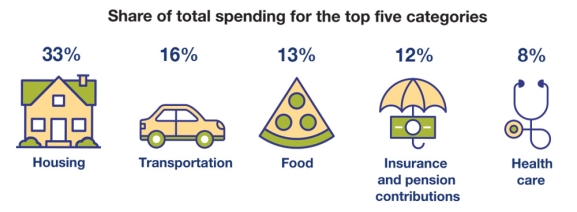If you find that you are struggling to pay down a credit card balance, here are some strategies that can help eliminate your credit card debt.
Pay off cards with the highest interest rate first. If you have more than one card that carries an outstanding balance, one option is to prioritize your payments according to their interest rates. Send as large a payment as you can to the card with the highest interest rate and continue making payments on the other cards until the card with the highest interest rate is paid off. You can then focus your repayment efforts on the card with the next-highest interest rate, and so on, until they’re all paid off.
Apply for a balance transfer with another card. Many credit card companies offer highly competitive balance transfer offers (e.g., 0% interest for 12 months). Transferring your credit card balance to a card with a lower interest rate may enable you to reduce interest fees and pay more against your existing balance.
Most balance transfer offers charge a fee (usually a percentage of the balance transferred), so be sure to do the calculations to make sure it’s cost-effective before you apply.
Pay more than the minimum. If you pay only the minimum payment due on a credit card, you’ll continue to carry the bulk of your balance forward without reducing your overall balance. Instead, try to make payments that exceed the minimum amount due. For more detailed information on the impact that making just the minimum payment will have on your overall balance, you can refer to your monthly statement.
Look for available funds to make a lump-sum payment. Are you expecting an employment bonus or other financial windfall in the near future? If so, consider using those funds to eliminate or pay down your credit card balance.
How can I improve my credit report?
Most lenders use credit report information to evaluate the creditworthiness of potential borrowers. Borrowers with good credit are presumed to be more creditworthy and may find it easier to obtain a loan, often at a lower interest rate.
You can do a number of things to help improve what’s on your credit report, including the following.
Pay bills on time. Your credit report provides information to lenders regarding your payment history. For the most part, a lender may assume that you can be trusted to make timely monthly debt payments in the future if you have done so in the past. Consequently, if you have a history of late payments and/or unpaid debts, a lender may consider you to be a high credit risk and turn you down for a loan.
Limit credit inquiries. Each time you apply for credit, the lender will request a copy of your credit report. The lender’s request then appears as a “hard inquiry” on your credit report. Too many of these inquiries in a short amount of time could be viewed negatively by a potential lender, since it may indicate that the borrower has a history of being turned down for loans or has access to too much credit.
Build a credit history. You may have good credit, but not enough of it. As a result, you may need to build up more of your credit history before a lender deems you worthy to take on new debt.
Correct errors on your report. Uncorrected errors on a credit report could make it difficult for a lender to accurately evaluate creditworthiness and could result in a loan denial. If you have errors on your credit report, it’s important to correct your report by disputing inaccurate or incomplete information,
Finally, if you are ever turned down for a loan, you can find out why. Under federal law, you are entitled to a free copy of your credit report as long as you request it within 60 days of receiving notice of a company’s adverse action against you. Federal law also entitles you to a free annual credit report from all three credit reporting agencies (Experian, Equifax™, and Trans Union™). You can obtain this report by visiting AnnualCreditReport.com.
If you have questions or would like more information
please contact Frank
Representatives are registered through, and securities are sold through Nationwide Planning Associates, Inc., Member FINRA/SIPC, located at 115 West Century Road, Suite 360, Paramus, NJ 07652. Investment advisory services are offered through NPA Asset Management, LLC. Insurance sold through licensed NPA Insurance Agency, Inc. agents. Nationwide Planning Associates, Inc. and Frankly Financial are non-affiliated entities.
This communication is strictly intended for individuals residing in the state(s) of CO, CT, FL, NJ, NY, NC, OH, PA and RI. No offers may be made or accepted from any resident outside the specific states referenced.
Prepared by Broadridge Advisor Solutions Copyright 2020.




